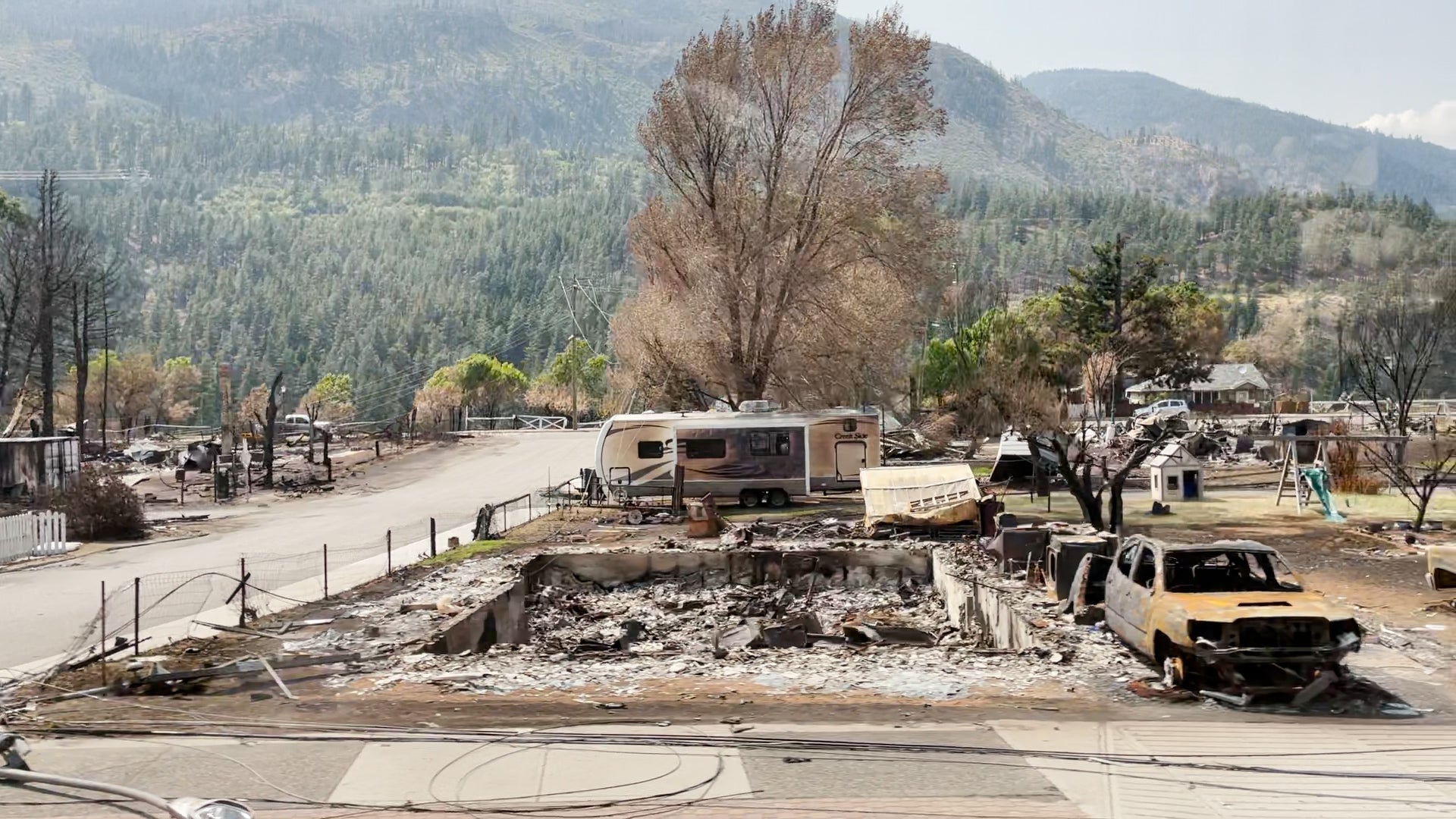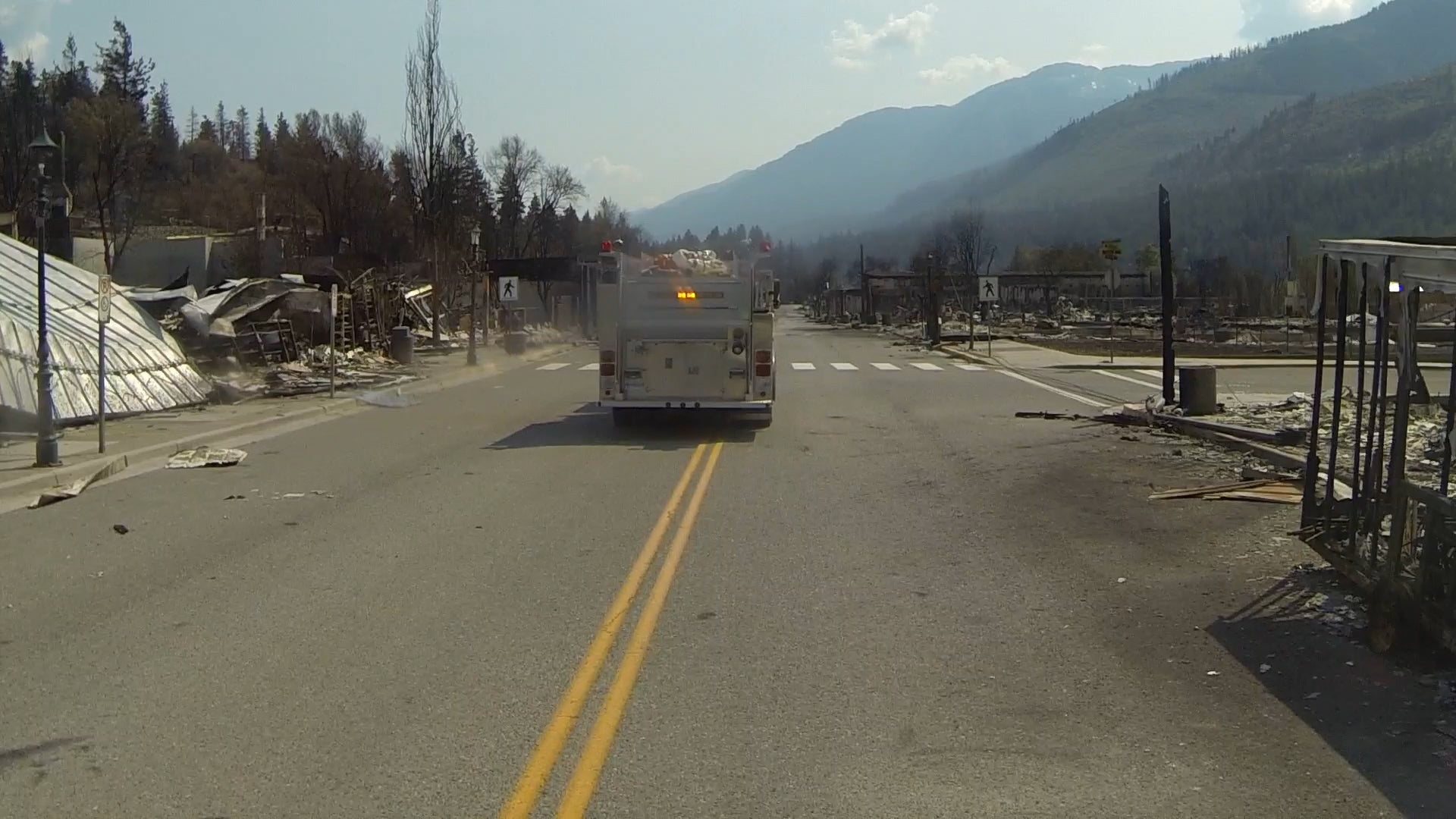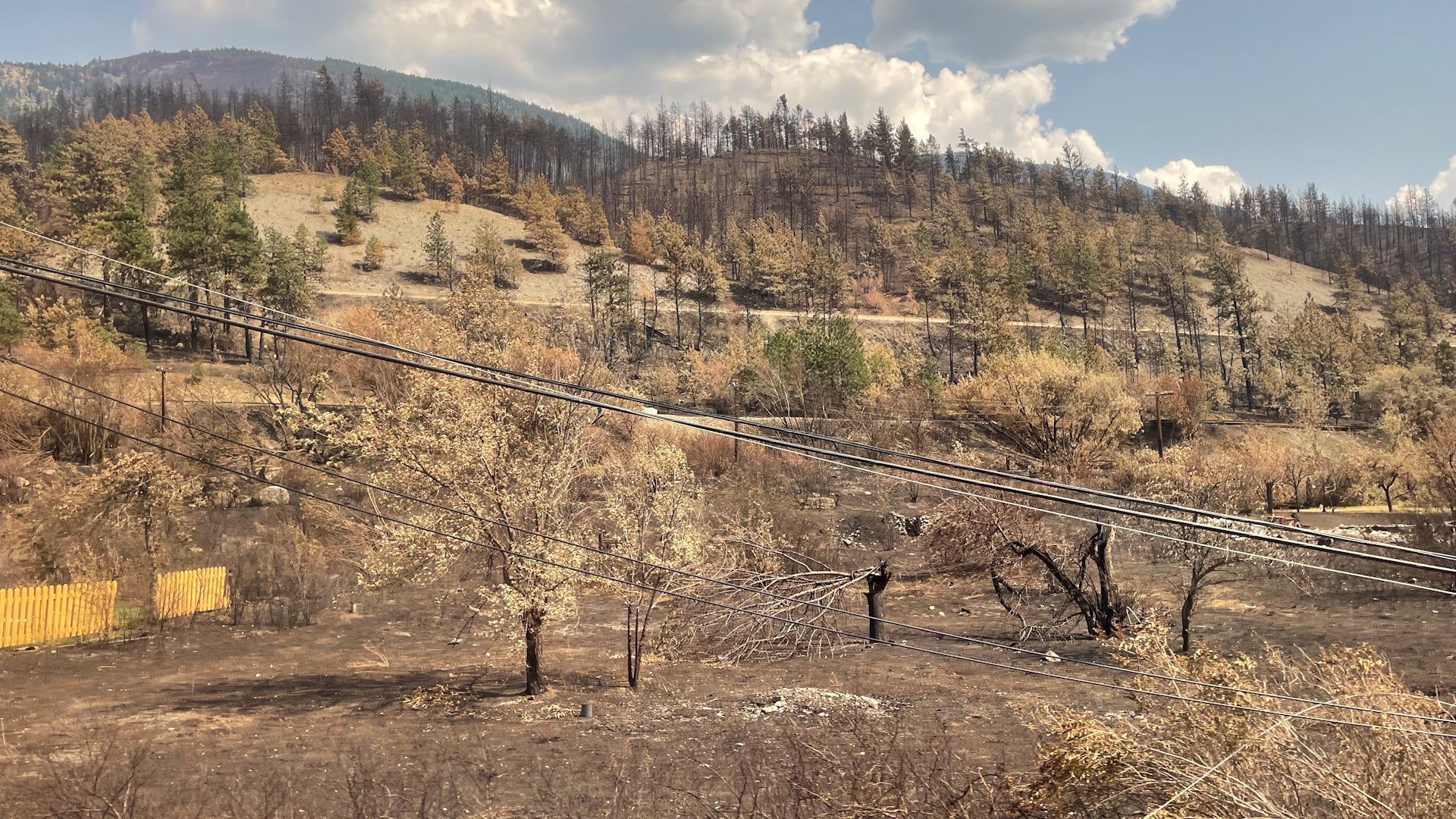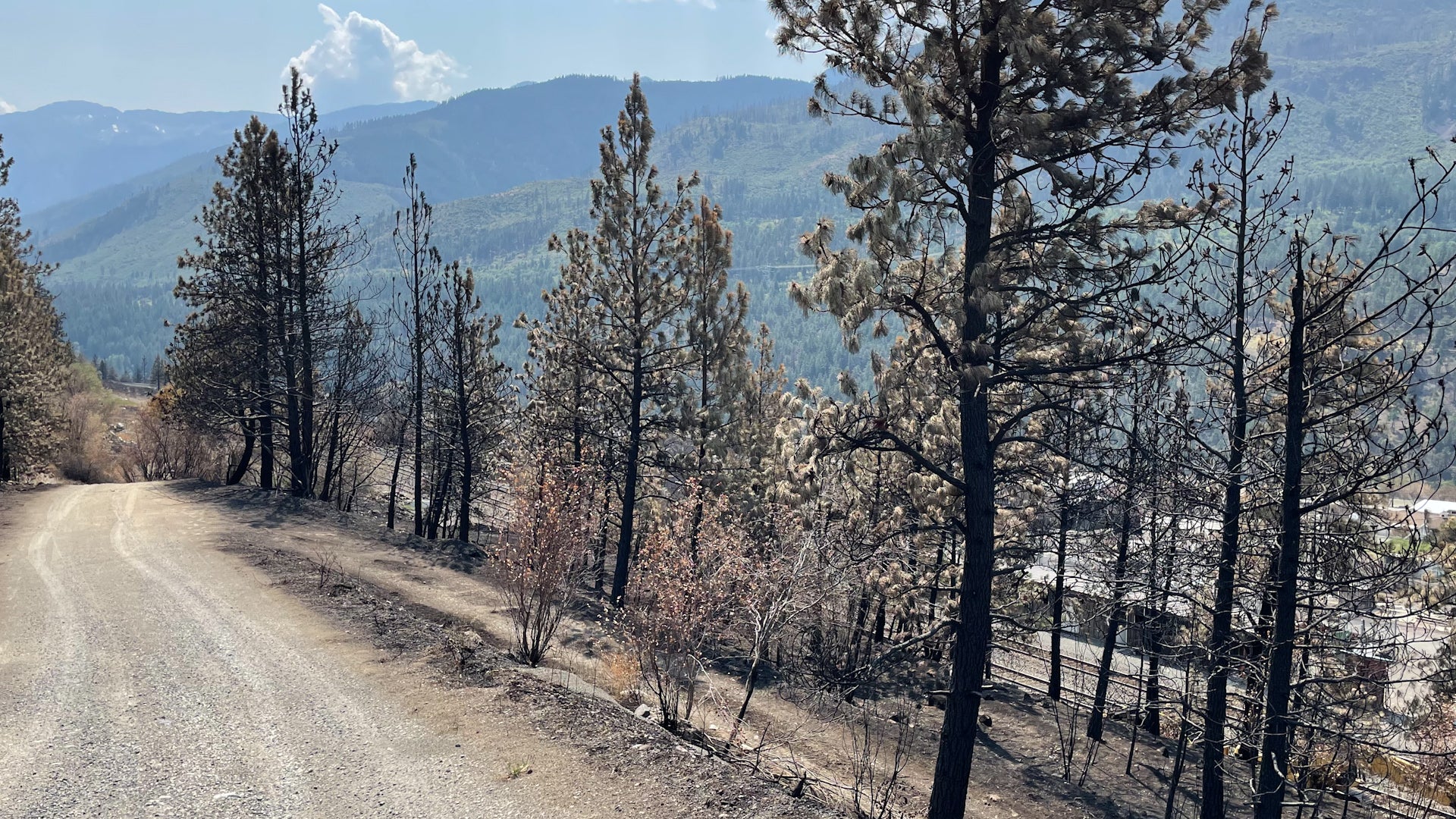First look inside town turned to ‘powder’ by record-breaking heatwave
The Independent was the first international news outlet to be allowed into the destroyed town of Lytton, British Columbia. Ashleigh Stewart joined residents seeing the extent of the destruction for the first time


Go Pro footage taken inside Lytton, in Canada’s British Columbia, shows the remains of a town residents described as a “special place” where “every takes care of each other”.
In place of homes once filled with people, and a lifetime’s worth of possessions, there is nothing but charred rubble. Video, take by The Independent, shows structures reduced to dust, ash scattered across the road, trees split apart by heat.
Objects once used by families are virtually unidentifiable, save for a few items that no doubt will take on a poignant significance for the families who revisited the charred remains of their homes this week.
All of Edith Loring-Kuhanga’s most prized possessions have been reduced to ash. Nothing remains of her home, other than the wire fence that runs around it, a large tree on the front of the property and an oil tank at the back. The rest is debris and charred earth.
And yet, the Lytton resident says seeing the remains of her home, and the decimated town around it, was a “tough but necessary” experience.

The small village was destroyed by a fire just days after it broke the record for Canada’s all-time highest temperature for three days in a row, reaching 121.1F (49.5C).
Lytton was among a number of areas in the Pacific Northwest that saw extreme heat over the last month; with places in across the border in California, Oregon and Washington in the US also breaking their own temperature records and reporting hundreds of deaths believed to be linked to the extreme heat.
Caused by what meteorologists have described as a “heat dome” of high pressure over the Pacific Northwest and Canada’s British Columbia, the impact has been worsened by human-caused climate change.
In Canada, the heat was so intense that experts said it set the perfect conditions for wildfires. However, investigators believe that the fire in Lytton may have been caused by humans.
Many Lytton residents on Friday returned to the town for the first time since fleeing the oncoming flames, to observe what remained. The Thompson-Nicola Regional District arranged buses to take evacuees, and a media contingent including The Independent, back into the town on a tightly controlled tour.
Loring-Kuhanga was one of those residents.

The school administrator for the Stein Valley Nlakapamux School, a First Nations school in Lytton, escaped the fire and helped set up the muster station at the local high school for evacuees. She then fled the town to Lillooet and is now staying in a hotel in Langley.
She says seeing the remains of the town was cathartic.

“You see a lot of news and a lot of social media, and for me I needed to see it myself. I felt it was part of my own healing,” she says.
“It was part of accepting it all too. That this really did happen.”
Driving through Lytton’s Main Street is a confronting experience. The vast majority of the buildings have been reduced to blackened rubble and twisted metal. Burnt out cars sit abandoned on the side of the road. The medical centre is a mangled heap of aluminium and bricks. So too is the town’s renowned Chinese History Museum.

Few buildings are still standing, but the ones that are seem to have escaped, without reason, entirely unscathed. One house sits in immaculate condition, its green lawn still vibrant; a jarring contrast to the surrounding charred properties. The post office and a church have also been spared.

As well as taking in the damage, Loring-Kuhanga says it was also a chance for Lytton residents, who were scattered across several nearby communities due to the speed at which everyone was forced to flee, to catch up again. The resident tour ran over-time due to everyone wanting to “hear each other’s stories”, she says.
“Everybody you talked to had their own story of how they escaped, who helped them, what they did and what they saw, what they took and what they didn’t take,” she explains.
“It was just so great to see each other, it was confirmation that you’re alive and you’re okay. We did ask if we should be crying or smiling. But we all said no, we’re so grateful to see each other and knowing that everyone is okay.”
As the bus drove through town, Loring-Kuhanga says residents were mostly silent, other than a few audible gasps or recognition of the remains of someone’s house.

While Loring-Kuhanga has only lived in Lytton for four years, her family has ties to the town that date back to the 1900s. A lot of her family’s traditional regalia was destroyed when her house went up in flames.
“That was all my memories and all of the possessions that I had. It’s all gone, It’s just all ashes.”
However, Loring-Kuhanga says every resident she spoke to today is adamant they want to return to the town and rebuild.
“Lytton is a very special place. There’s so much history there. It’s a small little town, everybody takes care of each other. There’s too much there to leave permanently.”
Jennifer Thoss agrees. She says Lytton is a “family”, all of whom will help each other get back on their feet.
Thoss was also on the bus tour, having lived in Lytton four four years, but now lives in Tsawwassen. However, she invested heavily in the town and now owns five rental properties there. All are now “powder”.
Thoss was in Lytton two days before the fire broke out, seeing one of her tenants and moving some of her own things into one of the properties she was renovating for herself, to spend summers in.
“I had my feet in Lytton Creek, having a beer with my friends. The fire started from that point a few days later.”

Thoss says the best part of the tour was seeing her neighbours and others she hadn’t seen since the fire, and the addition of a First Nations contingent who drummed for them as they got off the buses to visit the high school.
She says the most worrying aspect of the fires is how many people in the small town did not have home or contents insurance.
However, for others, returning to the town was too much. Pierre Quevillon said he declined joining the tour, because he knew the pick-up truck that he had packed his dogs into, ready to escape the town, was still there. The truck had caught fire, along with his dogs, before he had a chance to escape – leaving him to flee the town on foot.
Hours ahead of the residents’ tour on Friday, the federal government ordered trains to cease operations for 48 hours in the area.
Transport Minister Omar Alghabra issued the order “in the interest of safe railway operations, and to protect public safety for the temporary return of residents to inspect their homes in Lytton, British Columbia”, in a statement.
It comes as The Transportation Safety Board says it is now investigating the fire, after receiving information from the RCMP and BC Wildfire Service, who are trying to determine the cause of the blaze. Videos and witnesses have pointed to a burning train spotted near the town as a possible cause.
Join our commenting forum
Join thought-provoking conversations, follow other Independent readers and see their replies
Comments




Bookmark popover
Removed from bookmarks